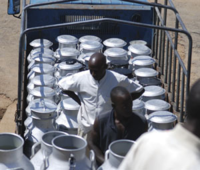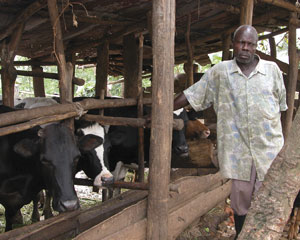Difference between revisions of "Biogas-Powered Evaporative Cooling for Uganda’s Dairy Industry"
***** (***** | *****) |
***** (***** | *****) m |
||
| (8 intermediate revisions by 3 users not shown) | |||
| Line 1: | Line 1: | ||
| − | |||
| − | |||
= Overview<br/> = | = Overview<br/> = | ||
| − | |||
| − | |||
{| style="width: 100%;" border="1" cellspacing="0" cellpadding="0" | {| style="width: 100%;" border="1" cellspacing="0" cellpadding="0" | ||
| Line 12: | Line 8: | ||
| style="width: 50%;" | | | style="width: 50%;" | | ||
'''[http://research.uga.edu/ugarf/ University of Georgia Research Foundation (UGARF)]'''<br/> | '''[http://research.uga.edu/ugarf/ University of Georgia Research Foundation (UGARF)]'''<br/> | ||
| − | + | ||
| − | | rowspan="4" | <p style="text-align: center;"><br/></p><p style="text-align: center;">[[File:Smallholderfortunes UGARF Logo.png|center|180px]]<br/></p><p style="text-align: center;" | + | | rowspan="4" | <p style="text-align: center;"><br/></p><p style="text-align: center;">[[File:Smallholderfortunes UGARF Logo.png|center|180px|alt=Smallholderfortunes UGARF Logo.png]]<br/></p><p style="text-align: center;"><br/></p> |
|- | |- | ||
| style="width: 25%;" | | | style="width: 25%;" | | ||
| Line 33: | Line 29: | ||
| style="width: 50%;" | | | style="width: 50%;" | | ||
| − | [[ | + | [[Uganda Energy Situation|Uganda]]<br/> |
|} | |} | ||
| − | Throughout sub-Saharan Africa, the dairy industry suffers from lack of proper refrigeration options. Large dairies cannot export milk to neighboring markets due to international standards requiring milk be cooled within four hours of production. Small farmers may lose 20-50% of milk to spoilage due to lack of cold-chain facilities. There is limited access to electricity for refrigeration units, and kerosene and solar-powered options have proved too expensive and difficult to operate. | + | Throughout sub-Saharan Africa, the dairy industry suffers from lack of proper refrigeration options. Large dairies cannot export milk to neighboring markets due to international standards requiring milk be [https://energypedia.info/index.php?title=Special:Search&profile=default&search=Cooling+for+Agriculture&fulltext=Search cooled] within four hours of production. Small farmers may lose 20-50% of milk to spoilage due to lack of cold-chain facilities. There is limited access to electricity for refrigeration units, and kerosene and solar-powered options have proved too expensive and difficult to operate.<br/> |
| − | |||
| − | <br/> | ||
<br/> | <br/> | ||
| − | |||
= Clean Energy Solution<br/> = | = Clean Energy Solution<br/> = | ||
| − | + | [http://research.uga.edu/ugarf University of Georgia Research Foundation (UGARF)] has developed a refrigeration unit powered on biogas - which is extracted from cow manure. The unit regenerates zeolite plates, which retain their capacity to capture water vapor from the evaporative milk chilling process. Partnered with Smallholder Fortunes, UGARF is refining the design of the refrigeration unit, and testing it with farmers in [[Uganda Energy Situation|Uganda]]. UGARF will work with local manufacturers to secure financing and bring production of the units to commercial scale.<ref name="Powering Agriculture, UGARF: http://poweringag.org/innovators/biogas-powered-evaporative-cooling-dairy-industry">Powering Agriculture, UGARF: http://poweringag.org/innovators/biogas-powered-evaporative-cooling-dairy-industry</ref><br/> | |
| + | <p style="text-align: center;">{{#widget:YouTube|id=JqzsaEra_E0|height=400|width=800}}<br/></p> | ||
| + | <br/> | ||
<br/> | <br/> | ||
| Line 52: | Line 47: | ||
= Impact<br/> = | = Impact<br/> = | ||
| − | [[File:Biogas powered evaporative cooling 2.png|thumb|right|200px|A milk transport | + | [[File:Biogas powered evaporative cooling 2.png|thumb|right|200px|A milk transport © UGARF]]This project has numerous social, economic, and environmental benefits. Refrigeration units will benefit dairy farmers by decreasing milk spoilage and increasing production and profits. Captured biogas can be used for lighting and cooking - saving income that would otherwise be spent on kerosene, and replacing the use of wood and charcoal for cooking. Also, by extracting biogas from cow manure, greenhouse gas emissions from fermenting cow manure is mitigated.<ref name="Powering Agriculture, UGARF: http://poweringag.org/innovators/biogas-powered-evaporative-cooling-dairy-industry">Powering Agriculture, UGARF: http://poweringag.org/innovators/biogas-powered-evaporative-cooling-dairy-industry</ref><br/> |
| + | |||
| + | [[File:Biogas powered evaporative cooling 1.png|thumb|left|300px|Farmer © UGARF]]<br/> | ||
| + | |||
| + | <br/> | ||
<br/> | <br/> | ||
| Line 61: | Line 60: | ||
<br/> | <br/> | ||
| + | |||
= Progress Update<br/> = | = Progress Update<br/> = | ||
| − | UGARF | + | As of September 2017, UGARF had deployed 34 EvaKuula units, with 5 additional units to be installed in the coming months. Half of the beneficiaries using the product are women, who have been successful users and provided important word-of-mouth marketing for the technology. User input has been an important piece of the product design process, with input from women ensuring that the product incorporates factors that are female-friendly. UGARF hopes to expand into Rwanda in the future. Next steps include conducting value engineering to lower the manufacturing cost well below the price point for the units. UGARF’s award has been extended to March 2018.<ref name="Powering Agriculture, UGARF: http://poweringag.org/innovators/biogas-powered-evaporative-cooling-dairy-industry">Powering Agriculture, UGARF: http://poweringag.org/innovators/biogas-powered-evaporative-cooling-dairy-industry</ref><br/> |
<br/> | <br/> | ||
| − | |||
= Further Information<br/> = | = Further Information<br/> = | ||
| − | *[[Portal: | + | *[[Portal:Water and Energy for Food|Water and Energy for Food (WE4F) portal on energypedia]] |
*[http://poweringag.org/innovators Powering Agriculture Homepage, Winners/ Innovators]<br/> | *[http://poweringag.org/innovators Powering Agriculture Homepage, Winners/ Innovators]<br/> | ||
| − | *[[ | + | *[[Powering Agriculture: An Energy Grand Challenge for Development|Powering Agriculture: An Energy Grand Challenge for Development]]<br/> |
*[https://poweringag.org/news-events/program-updates/newsletters Powering Agriculture Newsletters]<br/> | *[https://poweringag.org/news-events/program-updates/newsletters Powering Agriculture Newsletters]<br/> | ||
*[http://research.uga.edu/ugarf University of Georgia Research Foundation (UGARF) Homepage] | *[http://research.uga.edu/ugarf University of Georgia Research Foundation (UGARF) Homepage] | ||
| Line 80: | Line 79: | ||
*[[Uganda Energy Situation|Uganda Energy Situation]]<br/> | *[[Uganda Energy Situation|Uganda Energy Situation]]<br/> | ||
*[http://wbi.worldbank.org/wbdm/idea/renewable-energy-powered-milk-cooler-smallholder-dairy-farmers Renewable Energy-powered Milk Cooler for Smallholder Dairy Farmers]<br/> | *[http://wbi.worldbank.org/wbdm/idea/renewable-energy-powered-milk-cooler-smallholder-dairy-farmers Renewable Energy-powered Milk Cooler for Smallholder Dairy Farmers]<br/> | ||
| − | |||
| − | |||
<br/> | <br/> | ||
| Line 89: | Line 86: | ||
<references /> | <references /> | ||
| + | [[Category:Sub-Saharan_Africa]] | ||
| + | [[Category:Impacts]] | ||
| + | [[Category:Uganda]] | ||
| + | [[Category:Biogas]] | ||
[[Category:Powering_Agriculture]] | [[Category:Powering_Agriculture]] | ||
| − | |||
| − | |||
| − | |||
| − | |||
| − | |||
Latest revision as of 19:07, 14 July 2020
Overview
|
Innovator |
||
|
Project |
||
|
Collaborators |
Smallholder Fortunes (Uganda) | |
|
Location Applied |
Throughout sub-Saharan Africa, the dairy industry suffers from lack of proper refrigeration options. Large dairies cannot export milk to neighboring markets due to international standards requiring milk be cooled within four hours of production. Small farmers may lose 20-50% of milk to spoilage due to lack of cold-chain facilities. There is limited access to electricity for refrigeration units, and kerosene and solar-powered options have proved too expensive and difficult to operate.
Clean Energy Solution
University of Georgia Research Foundation (UGARF) has developed a refrigeration unit powered on biogas - which is extracted from cow manure. The unit regenerates zeolite plates, which retain their capacity to capture water vapor from the evaporative milk chilling process. Partnered with Smallholder Fortunes, UGARF is refining the design of the refrigeration unit, and testing it with farmers in Uganda. UGARF will work with local manufacturers to secure financing and bring production of the units to commercial scale.[1]
Impact
This project has numerous social, economic, and environmental benefits. Refrigeration units will benefit dairy farmers by decreasing milk spoilage and increasing production and profits. Captured biogas can be used for lighting and cooking - saving income that would otherwise be spent on kerosene, and replacing the use of wood and charcoal for cooking. Also, by extracting biogas from cow manure, greenhouse gas emissions from fermenting cow manure is mitigated.[1]
Organization
The University of Georgia Research Foundation, Inc. (UGARF) is a nonprofit entity housed within the University of Georgia (UGA) in the United States that enhances UGA’s excellence as a research and higher education institution. Smallholder Fortunes is a small-scale dairy farm located in Wakiso District, Uganda.[2]
Progress Update
As of September 2017, UGARF had deployed 34 EvaKuula units, with 5 additional units to be installed in the coming months. Half of the beneficiaries using the product are women, who have been successful users and provided important word-of-mouth marketing for the technology. User input has been an important piece of the product design process, with input from women ensuring that the product incorporates factors that are female-friendly. UGARF hopes to expand into Rwanda in the future. Next steps include conducting value engineering to lower the manufacturing cost well below the price point for the units. UGARF’s award has been extended to March 2018.[1]
Further Information
- Water and Energy for Food (WE4F) portal on energypedia
- Powering Agriculture Homepage, Winners/ Innovators
- Powering Agriculture: An Energy Grand Challenge for Development
- Powering Agriculture Newsletters
- University of Georgia Research Foundation (UGARF) Homepage
- Smallholder Fortunes Homepage
- Uganda Energy Situation
- Renewable Energy-powered Milk Cooler for Smallholder Dairy Farmers
References
- ↑ 1.0 1.1 1.2 Powering Agriculture, UGARF: http://poweringag.org/innovators/biogas-powered-evaporative-cooling-dairy-industry
- ↑ UGARF: http://research.uga.edu/ugarf





















